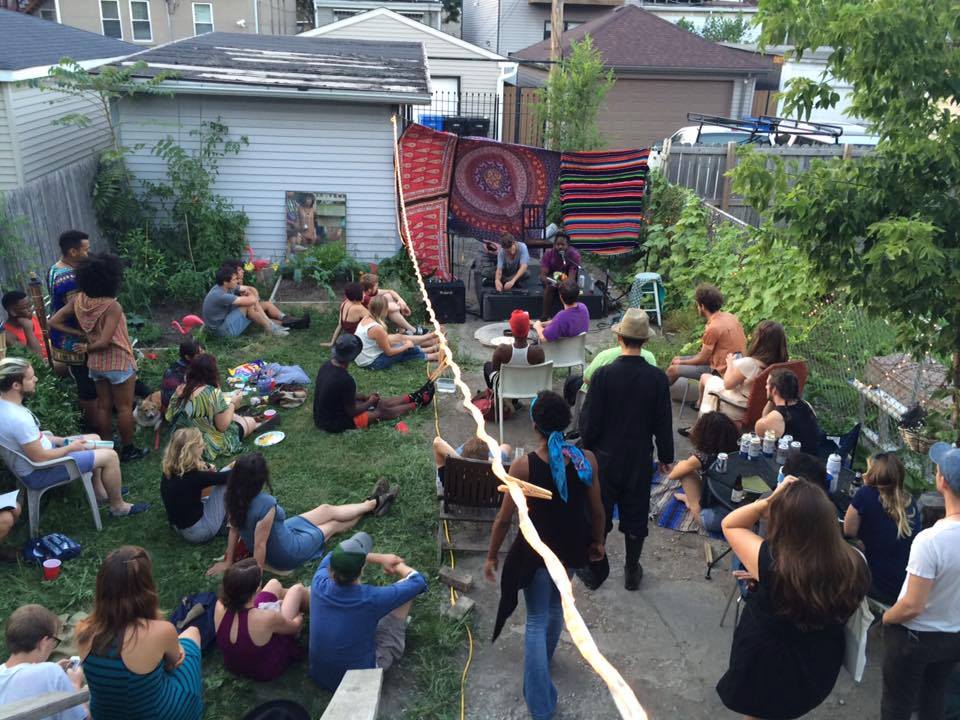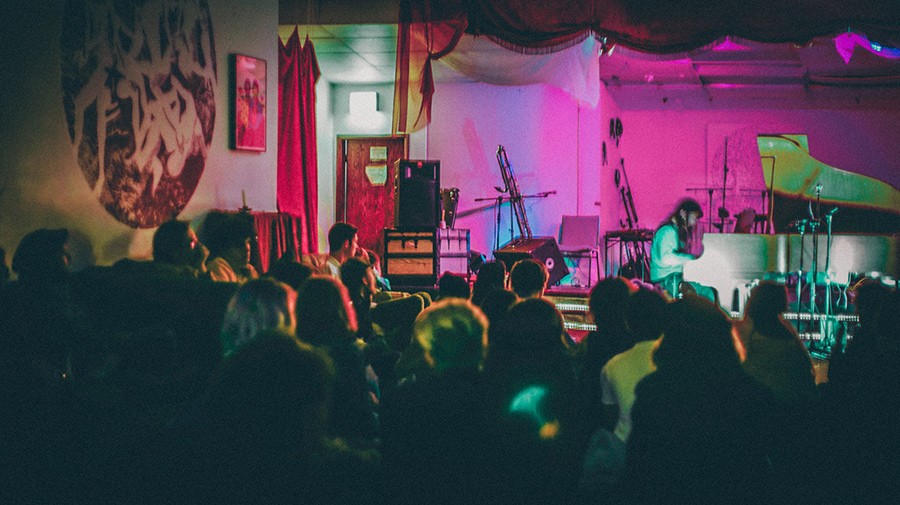By Grant Rindner
When Rae Bees came to Chicago from Tallahassee, she already had deep roots in Florida’s DIY culture that went back to her college days. When she arrived in the Windy City, she became involved with Hostel Earphoria, a house and creative space that hosts artists traveling through Chicago and looking for an authentic understanding of the city’s musical culture.
Hostel Earphoria in Logan Square also hosts shows and serves as a recording space. It is one of a number of renowned DIY (do-it-yourself) musical spaces in town that provide an alternative to the mainstream music and arts scenes. Recently, the tragic fire at Oakland’s Ghost Ship venue resulted in the loss of more than 30 lives, and put DIY culture at the forefront of media discussions in the United States.
Nearly every city has its own unique DIY underground culture, and in Chicago, the DIY scene has long been an essential component of the city’s underground musical culture. It helped breed labels like Drag City and Thrill Jockey as well as successful recent acts like Twin Peaks and The Walters.
But even for a community constantly in flux, it feels like 2016 is a particularly vulnerable moment in time with more prevalent police presence, stricter ordinances and a culture constantly on the move due to financial constraints and the lack of available space.
“I feel like we’re in this weird space, maybe in like 2008 or 2009 it was the height of DIY still being underground and not being exploited,” said artist David Beltran. “There was more freedom – it’s intertwined with the city too. The rent was a lot cheaper and everyone I knew lived in a loft or lived in a warehouse and every space was a DIY space. “
DIY by its very nature is ephemeral; its success is based on the willingness of people to offer up not only their time but often their homes for the sake of providing spaces for art and music. Beltran, who is an accomplished visual artist under the name Bae Cutler and also makes music as Starfoxxx, ran the venue Feeltrip in the South Loop until it closed in 2013. He described the profound impact that growing up in a rich DIY scene had on him in the mid-2000s.
“It felt a lot like the stories you hear about the New York art scene when Warhol and the Factory were coming up. You’d go to these houses [in Chicago] and see Kid Sister or Flosstradamus or Dan Deacon playing a show in the basement. When we were kids in high school we’d go to a show and you’d hear about these bands playing at these warehouse spaces that are owned by your friends.”
Now, Beltran said, the attitude of the city has had a dampening impact on the culture itself.
“I think we caught the last wave of it with Feeltrip in like 2012. Ever since then I feel like we have to be a little more creative with everything we do now since Chicago’s so strict.”

Stricter watch from the city and complaints from neighbors have led to the closing of many of the city’s best known DIY venues. Animal Kingdom, a DIY venue in Avondale, was renowned for the shows hosted in the home’s backyard. It was shut down in 2014 after complaints from neighbors . The converted church that housed the influential collective Young Camelot closed its doors this January after a fight broke out following an after-party for a concert at the Metro. Even beyond the venue closures, the DIY culture is constantly in geographic flux as the people who bring it to life move to different pockets of the city, which can create its own set of problems.
“I think our biggest issue unfortunately is landlords and our participation in gentrification,” said Bees, who currently helps run Earphoria. “We keep moving farther and farther west in the city and it brings an influx of people and increases in rent and then people have to move. That’s a huge conversation within all of us – whether we’re contributing to gentrification or not.”
Despite the openness and accommodating spirit of the DIY scene in terms of cost and inclusion, its veterans do lament that there are still barriers, both racial and musical, that they are trying to bridge. For Maureen Neer, who got involved with Young Camelot after moving to Chicago from Ohio, that came in the form of pushing the boundaries of who plays at her space.
“We just got so sick of seeing garage rock bands. That’s not interesting. That’s not the whole Chicago music story,” Neer said. “There’s women, there’s African-Americans, there’s white dudes. Trying to cover that whole spectrum is an interesting booking challenge…you meet so many people that way that you wouldn’t necessarily ever run into otherwise.”
Bees is also pushing for a more ethnically and sonically diverse scene. She started a new multi-cultural collective called Black and Brown Babes at Earphoria that has grown rapidly since it began seven months ago..
“I’ve talked multiple times to different venues and bookers who feel uncomfortable because they are white reaching out to black and brown bands that they haven’t met. They feel like they have to say, ‘Hey we want to make our lineup diverse, will you perform?” said Bees. “Currently I think people are very complacent and want to book their friends…. We’re tastemakers in a way so we should be more conscious of who we’re booking.”

Despite its organic roots, DIY hasn’t been immune from social media, and people with a history in the community are still unsure whether the advent of sites like Facebook are helpful or harmful for bringing people together.
“There’s a lot of cliquey, political stuff [with Facebook] that can undermine the people that are involved, especially from the organizational standpoint…Though I kind of wonder in the old days before the Internet how people got the word out,” Neer said. “But I do feel like Facebook has made things cliquey in a way.”
Bees acknowledged that the spread of social media makes it easier for anti-DIY forces to try and keep tabs on key locations and events, but believes that its communicative power is tremendously positive.
“For the longest time I think many communities have been very segregated, both racially and genre-wise. Now that there’s this larger discussion and people are able to connect and find music and bands more easily I think it’s been more positive than negative,” she said.
Above all, youth is a pillar of DIY culture. Beltran’s perspective was shaped by shows he attended as a senior in high school and throughout college, Bees got her start while at Florida State, and Neer stressed how the scene is strongly influenced by college kids in terms of its energy and intentions.
“DIY is very much a college cultural thing, I think the bulk of the people that go to these shows are college kids,” Neer said. “I think part of it is people growing up and just not doing it anymore.”
But those who have been ingrained in the world of the house show and makeshift galleries do still have a key role to play in guiding the culture forwards. In the case of Young Camelot, organizers are partnering with licensed venues to stage events, and Neer has even mulled over a way to stay integrated for the long haul. And the Neo-Futurists and underground theater flourish at more established venues across town.
“My friends and I have been joking about a geriatric DIY space, which would definitely be more low-key,” Neer said. “It’d be geared towards older people in the scene who maybe don’t want to party with a bunch of 20 year olds but still want to have that sense of community.”


